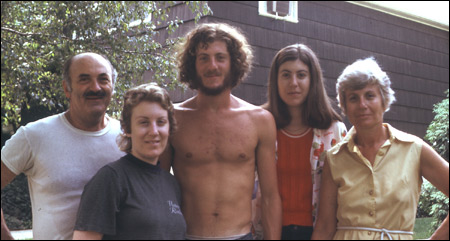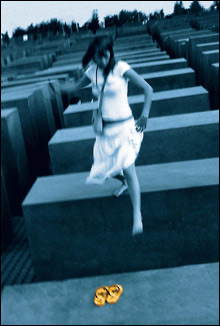
51 BIRCHSTREET: A a family interrogation that transforms into something like a Wide Sargasso Sea of Jewish-American suburbia. |
When film festivals are programmed as extensions of life, not merely celebrations of cinema, commerce, or hype, everybody wins. Regardless of the percentage of home runs versus dogs, our priorities can be realigned toward the realities of cultural heritage and away from the hot-media laser-sight point that otherwise tries to steer our socio-political vision. Quentin Tarantino and Timur Bekmambetov and Sofia Coppola find no quarter here, and neither does movie stardom or publicity or glossy-monthly otherworldliness. The “being Jewish” wrestled with in the BJFF knows nothing from Jewish gangsters or Jewish superheroes or Jewish vampires — it’s all about the sensible-shoes-on-the-ground grit and warmth of global life as it is now and has been in the last century. Which is to say, history experienced not by rulers but by citizens, something Jews know the way field mice know predator birds.
This year, as in the past and like similar festivals elsewhere, the BJFF revolves to a large degree around the 20th century’s persecutions. Holocaust documentaries may have become a relentless, Oscar-nominated running gag to some, but if we’re lucky they’ll never stop. Every fresh throng of them stings your eyes anew: only five years of industrial mayhem, but more than 50 years, so far, of non-fiction autopsy seems to have barely scratched the skin. Probably another century won’t exhaust the gargantuan web of soul-blasting stories still emerging from witnesses and the material record.

We all have known this well even as schoolchildren, but with each year’s crop of films the pre-adolescent awe returns. An utterly ordinary Shoah Foundation entry, which means it can darken your sky, Mimmo Calopresti’s VOLEVO SOLO VIVERE|I ONLY WANTED TO LIVE (2006; MFA November 12 at 2 pm, with the director) is a prime example: interviewing still more camp survivors in the Lanzmann style, this time attending to the post-Mussolini invasion of Italy and the fate of the more than 6000 Italian Jews shipped out to Auschwitz, Birkenau, et al. Paradigmatically appalling, the testimony of Calopresti’s nine matter-of-fact witnesses, abetted by archival footage, spans years, from Mussolini’s 1938 dictum about “the Jewish problem” to in-camp meetings with Mengele (one of the survivors was the doctor’s Italian interpreter) and the final liberations. These are nine passionate but calm grandmas and grandpas who long ago found ways to tell their stories without melting. The scalding peak moment of Calopresti’s film might be the first-hand account of one man whose job it was to shave women at the entrance to the Auschwitz showers and then help jockey the corpses at an assembly-line pace into the ovens.

VOLEVO SOLO VIVERE: An utterly ordinary Shoah Foundation entry — which means it can darken your sky. |
In contrast, THE RAPE OF EUROPA (2006; MFA November 12 at 6:30 pm) is a day in the park — an alternative history of the Third Reich’s ravages that focuses, for a change, not on the human destruction but the Nazis’ scorched-earth impact on European art and architecture. Filmmakers Richard Berge, Bonni Cohen, and Nicole Newnham are, I think, assuming that after so much documentation of murder and torture we could stand to consider instead the material and cultural losses: the paintings stolen and lost, the centuries-old landmarks devastated (and not by the Germans — the Allied bombing of the Monte Cassino monastery is a centerpiece), the sculptures frantically smuggled to outlying estates before art mavens Hitler and Goering could get their greedy mitts on them. Still, in one example after another, it seems more than odd to worry about a hidden Leonardo, or the looted homestead of Dostoyevsky, rather than about butchered civilians or genocide. Meticulously researched, and narrated in reverent tones by Joan Allen, The Rape of Europa is intended as an adjunct document to Holocaust culture, and one has to keep reminding oneself of that fact amid the feverish art-love tunnel vision.Non-fiction-film queen Heddy Honigman registers fabulously in her 26-minute short “FOOD FOR LOVE: A SHTETL THAT’S NO LONGER THERE” (2004; Coolidge Corner November 6 at 6:30 pm), a simple document of Honigman’s own mother cooking vrennekes and telling her life story of Polish childhood, Holocaust loss, and breathless flight to Peru. It makes a good deal more old-school Mitteleuropean sense than Richard Dindo’s WER WAR FRANZ KAFKA?|WHO WAS FRANZ KAFKA? (2005; Coolidge Corner November 8 at 6 pm), a mock-documentary bio-pic of a writer who needs no more biographies. Dindo disinters the never-out-of-print letters and diaries and has hammy actors in costume read them while superimposed over lovely swatches of Prague. Nothing new is revealed for literate high-school grads, but it’s still not the hagiographic swoon of WRESTLING WITH ANGELS (2006; MFA November 7 at 7 pm), which profiles playwright Tony Kushner — who as far as we know hasn’t won a Nobel or cured cancer — with the same dull-eyed sycophancy director Freida Lee Mock brought to Maya Lin, Rose Kennedy, and Vietnam POWs.